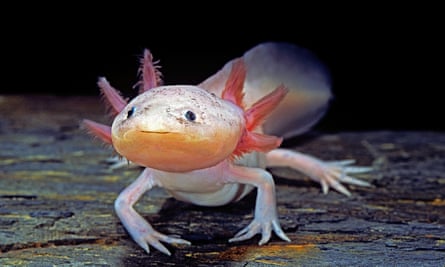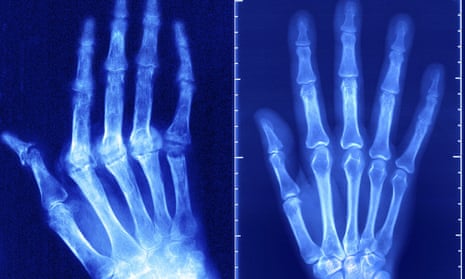Contrary to popular opinion, humans can regrow cartilage in their joints, researchers have found. Experts hope the research could lead to new treatments for a common type of arthritis.
Osteoarthritis, in which joints become painful and stiff, is the most common form of arthritis and is thought to cause pain in about 8.5 million people in the UK alone. It is caused by a breakdown in the cartilage that protects the ends of the bones, as well as the growth of new bone around the joint as the body tries to repair the damage.
It has long been thought that adult humans are unable to produce new cartilage, unlike a number of animals, including salamanders, which can not only repair damage to joints but grow whole new limbs.
Now researchers say they have found fresh evidence that adults can produce new cartilage. They say the process is more common in joints less prone to osteoarthritis, and appears to be linked to small molecules that control the regrowth of limbs in animals such as the salamander.
“We like to call it our inner salamander,” said Prof Virginia Kraus, the co-author of the research from Duke University, in North Carolina.
Writing in the journal Science Advances, Kraus and colleagues describe how, as proteins age, their amino acid building blocks undergo a particular chemical modification. If the rate of this chemical change is known, it is possible to work out the ratio of young to old proteins in tissue by looking at the degree to which these changes have built up.

Using samples of cartilage proteins from 18 individuals, the team found this rate of change was different for different proteins. However, cartilage proteins in the ankle typically accumulated fewer of these changes than those in the knee, and even fewer than those in hips, suggesting proteins in the ankle are younger and that the joint has a greater capacity for repair.
“We suddenly started noticing that the ankle proteins tended by and large to be much younger than the same proteins in the knee and the same proteins in the hip,” said Kraus.
Kraus said that might be an evolutionary hangover, noting that it was easier for animals such as salamanders to regenerate a part of a limb that is further away from their core – like a digit. Kraus said that might be because these distant body parts were more likely to be damaged in an attack that leaves the animal able to escape.
Further work revealed the ankle contained higher levels of small molecules called microRNAs that play a key role in limb regeneration in animals such as salamanders.
“There is much more of these [particular microRNAs] in the ankle than in the knee and more in the knee than in the hip,” said Kraus, adding that they appeared to be involved in turning off genes that repress the production of cartilage proteins. These microRNAs also appear to show a stronger link to the turnover rate of cartilage protein levels in people with osteoarthritis than those without. Kraus says this suggests the cartilage is increasing its capacity to repair, but remains inadequate in afflicted joints.
Various microRNAs have previously been linked to the development of osteoarthritis, while work in animals has suggested injections of certain microRNAs might slow osteoarthritis progression.
While the latest study has limitations – including that it only looks at a subset of cartilage proteins – it adds weight to the idea that injecting human joints with microRNAs, shown by the team to be linked to cartilage protein production, might aid their repair.
The team even suggests that if the other substances involved in limb regeneration in creatures such as salamanders were unpicked, it might be possible to use these in humans to trigger the regrowth of limbs. “That would be extremely exciting,” said Kraus.
The findings support recent work from researchers in the Netherlands, which showed cartilage in adult humans becomes thicker when knee joints are pulled apart.
Dr Fiona Watt, of the Kennedy Institute of Rheumatology, at the University of Oxford, said the study highlighted a possible mechanism by which cartilage repairs itself, and why some joints are more prone to osteoarthritis. She stressed it was important to carry out long-term studies looking at how such processes might change in individuals as they develop osteoarthritis, and explore when might be best to intervene.
She was cautious about injecting microRNAs into joints. “Clearly they are enhancing these proteins, but they may have off-target effects and have some sort of effect on things that you don’t want to target,” she said, adding that it was also important to investigate whether they would persist long enough if injected into a joint to produce an effect – and how long that effect would last.
The idea of limb regeneration would be even more complex. “It is probably quite optimistic,” said Watt. “But I think if we could improve growth of at least a single tissue like cartilage that would be a really great start.”
